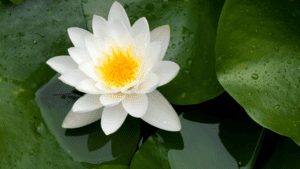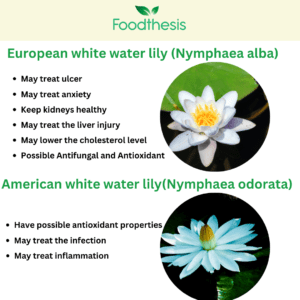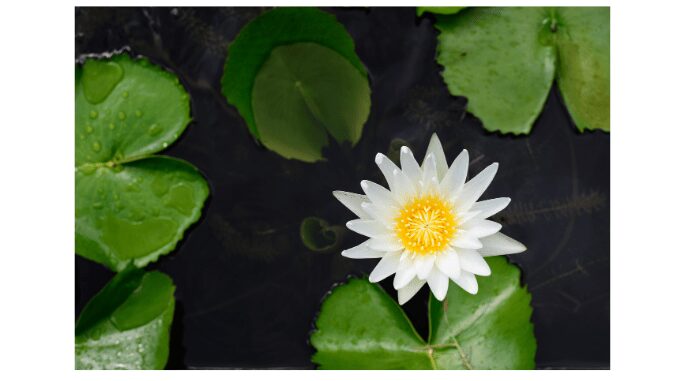White water lily facts
|
Introduction
White water lily (family Nymphaeaceae) are aquatic flowering plants that live in temperate and tropical climates. It grows in still or slowly moving water such as shallow ponds, streams, and the edges of lakes. It is being consumed as food and medicine for the treatment of various life-threatening diseases. Water lilies are a group of plants containing about 70 known species.
They have strong roots and attractive floating leaves with fragrance flowers. There are two common types of white water lily, European (Nymphaea alba) and American white water lily (Nymphaea odorata).
European white water lily

It is a perennial plant with perennial with black rhizomes submerged in the mud. It contains tannic acid, gallic acid, alkaloids, sterols, flavonoids, glycosides, and polyphenolic compounds.
Common name
- Kumuda
- White Lotus
- Water lily
- Nenuphar
- Nilofar
- White water rose
Geographical distribution
It is grown in Europe, North Africa, Southwest Asia, India, China, Finland, Turkey, Poland, and Russia (1).
Botanical description
Stem
It grows from an underwater stem at a depth of about 0.5 to 3 meters, in water over mud, silt, or peat.
Leaves
The leaves are large, round, and leathery up to 30 centimeters in diameter.
Flower
The flowers are multi-petaled, white and they have bright yellow stamen in the center. The flowers bloom usually during spring (from June to September) (2).
Rhizome or root
This plant has black, strong, and barely branched rhizome
Seeds
Seeds are smooth, and olive green in color (3).
Health benefits White water lily
All parts of the plant are used to treat bacterial infections of the anus, throat, or urethra (gonorrhea), diarrhea, and thick, whitish, yellowish, or greenish vaginal discharge (leucorrhoea).
1. May lower the cholesterol level
High cholesterol is associated with heart disease. However, its leaf extract contains flavonoids that help to reduce the cholesterol level. Much more study is needed to rate the effectiveness of this plant on humans (4).
2. Possible Antifungal, Anti-tumoral, and Antioxidant
European white water lily leaves and roots contain antioxidants like polyphenol and flavonoids mainly quercetin. These compounds stop the growth of Candida glabrata fungus.
It also fights against ovarian, prostate, and breast cancer cells without harming the noncancerous cells. Thus, this plant may act as an immune booster and prevent infection in cancer patients (5).
3. White water lily may treat the liver injury
Phenolic compounds mainly ellagitannins and flavonoids found in the leaves of this plant help to reduce the swelling of the liver (6).
4. May treat ulcer
The presence of tannin and flavonoids in the flower of the European lily inhibits stomach lesions. It helps to reduce gastric fluid volume and acidity. Thus, this plant exerts ulcer healing properties (7).
5. Possibly treat Diabetes
Intake of these plant leaves reduces blood glucose levels and controls diabetes (8).
6. May be useful in epilepsy/seizures
Epilepsy is one type of disorder of brain function characterized by periods of unusual behavior and causes seizures.
However, it contains flavonoids, tannins, and saponins. These compounds are beneficial to decrease the duration of the seizure.
Further study is needed to establish its usefulness in humans (9).
7. May treat anxiety
It produces calming and sedative effects on the nervous system. It helps to reduce insomnia, anxiety, and muscle tension disorders due to muscle relaxant properties (10).
8. Keep kidneys healthy
This plant helps to fight against oxidative damage and protect the kidney from injury (11).
Side effects
No side effects have been reported. However, precaution should be needed before consumption in high amounts.
How to eat?
European white water lily is a rich source of energy and contains a high level of nitrogen-free extract. The leaves and flowers are rich in crude protein.
Also, leaf stalks contain fiber in high amounts. Furthermore, minerals like potassium, sodium, and calcium levels are high while copper and zinc are low in this plant (12).
Fruits of this plant are eaten as food by some communities, in the Northern region of Ghana. The root can be used as a beverage plant to make tea and liquor.
The roasted seed may be used as a coffee substitute and young, unfurling leaves may be eaten raw or cooked.
American white water lily

American white water lily is a hardy, floating aquatic plant that produces a large and very fragrant white flower. This plant contains tannins (tannic acids and gallic acids) and alkaloids (nymphaerine and nupharine). Also, rich in glycosides (cardenolide and myrictrin) (13).
Common name
Sweet-Scented Water Lily, Cow cabbage, Water cabbage, a Water nymph, Water Queen, Fairy Boots, Alligator Bonnet, Alligator Blankets, Beaver Roots
Geographical distribution
This plant is native to North America (the USA and Canada), Central America, and the Caribbean (14).
Botanical description
American white water lily forms dense colonies, sometimes completely covering the surface of the water with leaves and branched creeping plants.
These leaves are three types immersed, which remain submerged; surface, which floats on the water’s surface; and aerial, which are held above the water (15).
Height
This plant can grow up to 30cm to 2 m (1.5′ to 6.5′) in height) and spread up to 2 to 4 feet.
The rhizome or roots
The root or rhizome is fleshy, and brown, and remains buried in the sediment below the water’s surface.
Leaves
Leaves are large, dark green, shiny, waxy above and reddish or purplish, and more or less hairy on the under surface.
The submerged leaves have short stalks and smooth blades. Its texture is rather leathery and thick.
Flower
The flower of this plant has many white petals with round leaves and contains yellow stamens. It usually opens in the morning, but typically closes by mid-afternoon and remains closed at night (16).
Fruit and seeds
Fruits are leathery, ovoid berry-like capsules with many small gray to orange seeds.
Health benefits
1. May treat the infection
It decreases the effect of carcinogens (the agent that causes cancer). It also destroys the development of bacteria and other microorganisms (17).
2. Have possible antioxidant properties
It contains antioxidants such as alkaloids, tannins, flavonoids, and glycosides. These compounds prevent the generation of harmful radicals and protect the liver and pancreas from oxidative damage (18).
3. May treat inflammation
American water lily root tea helps to reduce swelling and cough. Thus, this plant is useful to treat tuberculosis, dysentery, diarrhea, sores, sore throats, and rash (19).
How to eat?
Young leaves and flowers can be consumed raw.
Chopped leaves can be used in soups and stews.
Flower buds are pickled or eaten as cooked vegetables.
Roots or rhizomes may be intake after boiled, roasted, or prepared like potatoes.
Side effects
There is not enough scientific evidence reported about the safety of taking American white water lily. Thus, precaution should be needed before consumption in high amounts.

Q&A
1. What is the other name of the white water lily?
It is also known as white lotus, sweet-scented water lily, water cabbage, a water nymph, white pond lily, and many other names.
2. Where to order the American white water lily?
You can order online from the following site
3. Who does a white water lily refer to?
It takes its name from the Greek word; numphe which means virgin or water nymphe. This plant is also known as the goddess of water in both Greek and Roman mythology.
4. Where did the white water lily originate from
They originate from North Africa, temperate Asia, Europe, and tropical Asia.
